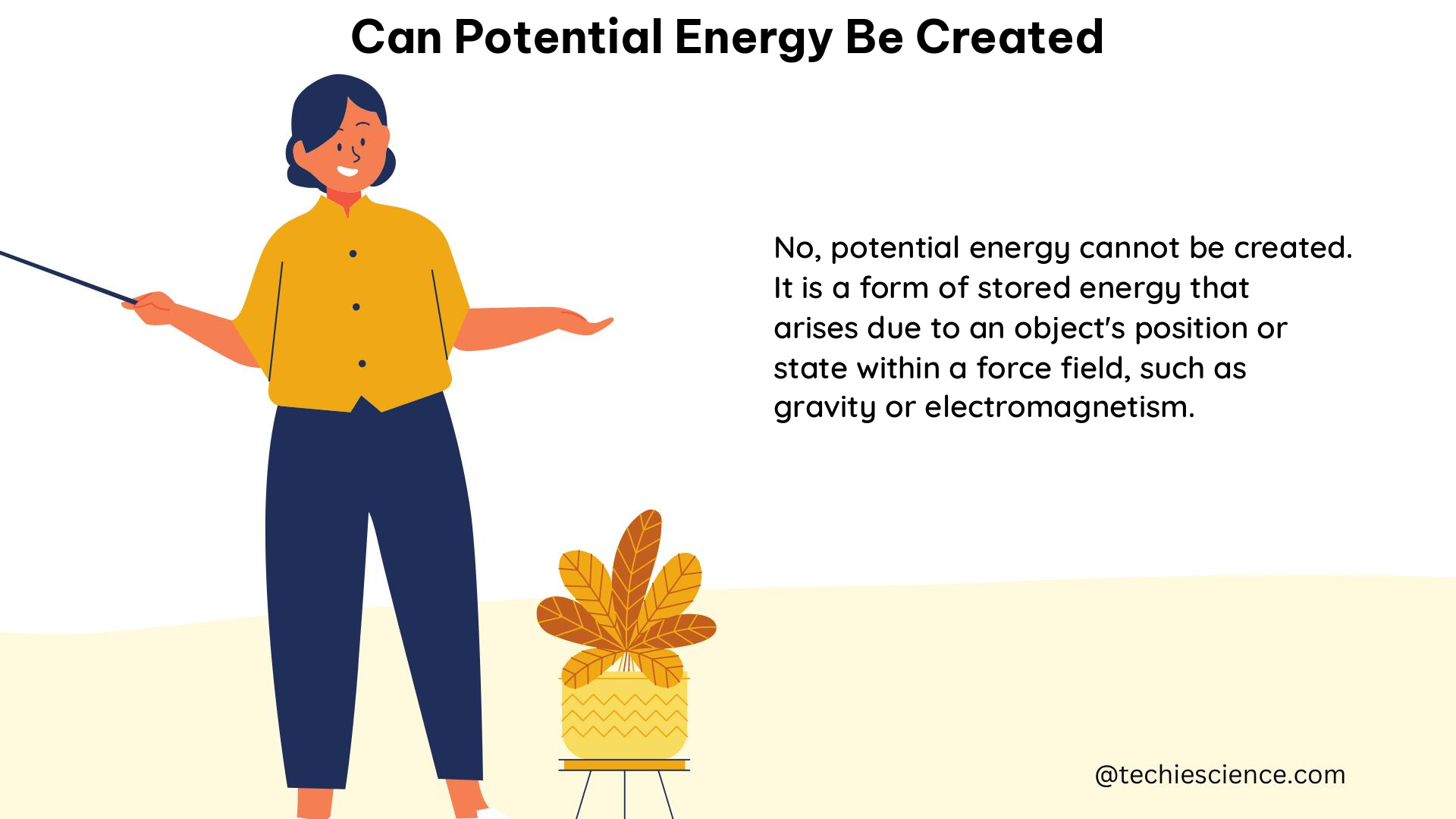In the realm of physics, the concept of potential energy is a fundamental principle that governs the behavior of various systems. Potential energy is the energy possessed by an object due to its position, configuration, or state, and it is a crucial component in understanding the conservation of energy. The question of whether potential energy can be created is a topic of great interest and importance in the field of physics.
Understanding Potential Energy
Potential energy is a scalar quantity, meaning it has only magnitude and no direction. It is often denoted by the symbol U or PE. The formula for potential energy depends on the type of force involved. For example, gravitational potential energy is given by the formula PE = mgh, where m is the mass of the object, g is the acceleration due to gravity, and h is the height above the ground.
Potential energy can take various forms, including:
-
Gravitational Potential Energy: This type of potential energy is associated with the position of an object in a gravitational field. When an object is lifted to a higher position, it gains gravitational potential energy.
-
Elastic Potential Energy: This type of potential energy is associated with the deformation of an elastic object, such as a stretched or compressed spring.
-
Electrical Potential Energy: This type of potential energy is associated with the position of a charged particle in an electric field.
-
Nuclear Potential Energy: This type of potential energy is associated with the configuration of nucleons (protons and neutrons) within the nucleus of an atom.
The Law of Conservation of Energy

The law of conservation of energy states that energy cannot be created or destroyed, but it can be transformed from one form to another. This fundamental principle is the foundation for understanding the concept of potential energy.
According to the law of conservation of energy, the total energy of an isolated system remains constant; it is said to be conserved over time. Energy can neither be created nor destroyed; rather, it can only be transformed or transferred from one form to another.
Can Potential Energy Be Created?
Based on the law of conservation of energy, the answer to the question “Can potential energy be created?” is no. Potential energy cannot be created, but it can be stored and released through the transformation of energy from one form to another.
When an object is in a position or configuration that allows it to possess potential energy, that potential energy is not being created but rather stored. For example, when a ball is placed on a shelf, it has gravitational potential energy due to its height above the ground. This potential energy is not being created; it is simply the result of the ball’s position in the gravitational field.
Similarly, when a spring is compressed or stretched, it stores elastic potential energy. This potential energy is not being created but rather stored in the deformation of the spring.
The process of converting one form of energy into potential energy is known as energy storage. This stored potential energy can then be released and converted into other forms of energy, such as kinetic energy or thermal energy, as the object or system changes its position or configuration.
Examples of Potential Energy Transformation
-
Gravitational Potential Energy: Consider a ball at rest on a shelf. The ball has gravitational potential energy due to its height above the ground. When the ball is released, its potential energy is converted into kinetic energy as it falls towards the ground.
-
Elastic Potential Energy: Imagine a compressed spring. The spring has elastic potential energy due to its deformation. When the spring is released, its potential energy is converted into kinetic energy as the spring expands.
-
Electrical Potential Energy: A charged particle in an electric field possesses electrical potential energy. When the particle moves within the electric field, its potential energy is converted into kinetic energy or other forms of energy.
-
Nuclear Potential Energy: The nucleons (protons and neutrons) within the nucleus of an atom possess nuclear potential energy due to the strong nuclear force. This potential energy can be released through nuclear reactions, such as fission or fusion, which convert the potential energy into other forms of energy, like thermal or kinetic energy.
Numerical Examples
- Gravitational Potential Energy: A 5 kg object is lifted to a height of 10 meters above the ground. Calculate the gravitational potential energy of the object.
Given:
– Mass (m) = 5 kg
– Height (h) = 10 m
– Acceleration due to gravity (g) = 9.8 m/s²
Gravitational Potential Energy (PE) = m × g × h
PE = 5 kg × 9.8 m/s² × 10 m
PE = 490 J
- Elastic Potential Energy: A spring with a spring constant of 500 N/m is compressed by 0.2 meters. Calculate the elastic potential energy stored in the spring.
Given:
– Spring constant (k) = 500 N/m
– Compression (x) = 0.2 m
Elastic Potential Energy (PE) = 1/2 × k × x²
PE = 1/2 × 500 N/m × (0.2 m)²
PE = 10 J
These examples demonstrate how potential energy can be calculated and transformed from one form to another, while adhering to the law of conservation of energy.
Conclusion
In conclusion, potential energy cannot be created, but it can be stored and released through the transformation of energy from one form to another. The law of conservation of energy is the fundamental principle that governs the behavior of potential energy, ensuring that energy is neither created nor destroyed, but rather transformed. Understanding the concept of potential energy and its various forms is crucial in the study of physics, particularly in the fields of mechanics, thermodynamics, and energy systems.
References:
- Potential Energy – an overview | ScienceDirect Topics
https://www.sciencedirect.com/topics/engineering/potential-energy - A doubt in the concept of potential energy – Physics Stack Exchange
https://physics.stackexchange.com/questions/522086/a-doubt-in-the-concept-of-potential-energy - Can Potential Energy Be Created? – Physics Forums
https://www.physicsforums.com/threads/can-potential-energy-be-created.923743/ - Conservation of Energy – Wikipedia
https://en.wikipedia.org/wiki/Conservation_of_energy - Potential Energy Formula and Examples – Physics Classroom
https://www.physicsclassroom.com/class/energy/Lesson-1/Potential-Energy

Hi,
I am Megha B R, I have completed my Post-Graduation in Solid State Physics and pursuing B. Ed. I am a Physics enthusiast. As an Academic writer, my goal is to reach the readers in a simplified manner through my articles.
Let’s connect through LinkedIn-